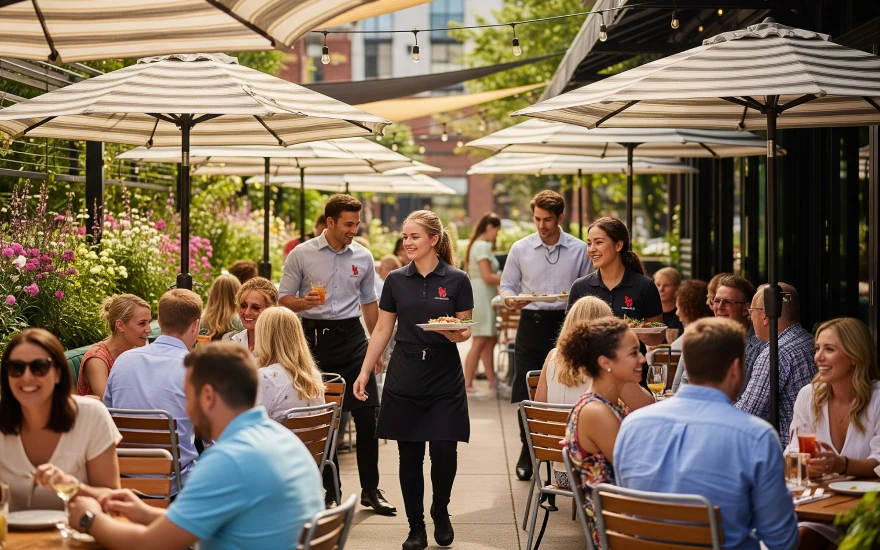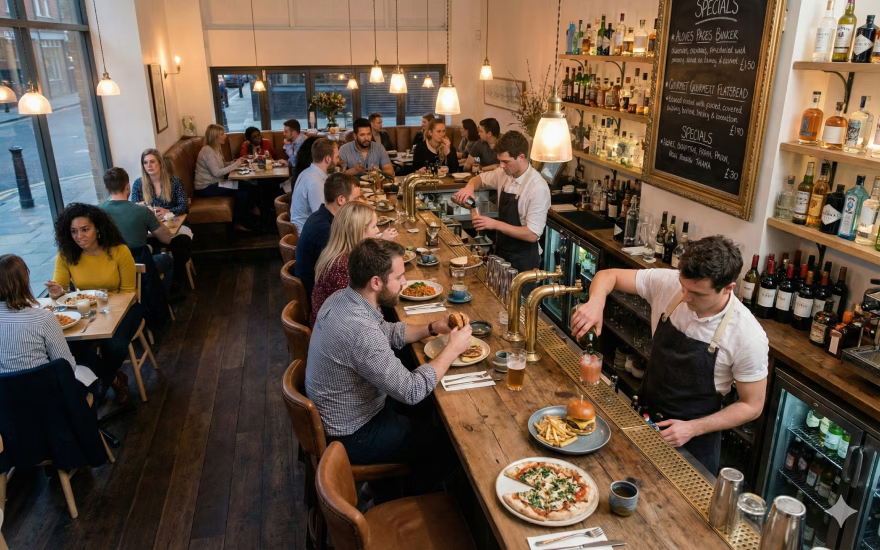How Overtourism Is Impacting Restaurant Hiring and Staffing in 2025

As tourism rebounds with intensity in 2025, so too do the pressures on restaurants in popular travel destinations. From bustling Barcelona to overbooked New York City, the surge in travelers is reshaping everything from dining demand to labor dynamics. One thing is clear: the overtourism impact on restaurant staffing is no longer a seasonal inconvenience — it is a year-round operational challenge demanding smarter solutions.
What Is Overtourism and Why Should Restaurant Owners Care?
Overtourism refers to the phenomenon where a destination receives more visitors than it can sustainably accommodate — impacting infrastructure, resources, and the local workforce. In 2025, cities around the world are bracing for what experts are calling a record-breaking year in travel.
For example, Spain is projected to receive more than 90 million visitors this year, according to a BBC report. In reaction, government agencies are launching counter-strategies: Venice introduced an entry fee for day-trippers, while Copenhagen’s “CopenPay” program rewards sustainable tourist behavior. Protests from residents are also sparking new travel restrictions, including bans on short-term rentals in cities like Barcelona and New York.
For restaurants, this uptick in travel translates to more guests, but also more strain. Labor demand rises, yet housing costs, local regulations, and burnout make finding and keeping workers more difficult.
How Does Overtourism Affect Restaurant Staffing in Tourist Hubs?
While increased foot traffic might suggest higher revenue potential, overtourism often creates labor chaos for restaurants.
Popular destinations such as Santorini, Mallorca, and Barcelona are experiencing infrastructure stress that limits the mobility and availability of hospitality workers. Hotel staff, servers, hosts, and line cooks are struggling to live near their places of work due to skyrocketing rents and unavailable housing.
Housing Shortages Affecting Workforce Supply
Short-term rental bans are pushing hospitality employees out of accessible urban centers. In Barcelona, authorities are taking aim at Airbnb-style rentals to combat the lack of affordable housing for residents — a move that also impacts the city’s frontline workforce. According to the BBC, similar restrictions are also being considered in cities like New York and Edinburgh, further tightening the labor funnel for restaurants.
Overcrowding and Guest Expectations Raising Service Pressure
As crowd sizes boom, guest expectations rise — but restaurants cannot keep pace without the right staff. The result? Overworked employees, longer service times, and increased customer complaints.
What Hiring and Staffing Challenges Are Restaurants Facing in 2025?
Restaurants aren’t just facing higher demand — they are grappling with structural hiring challenges worsened by overtourism.
Staffing cycles that used to be seasonal are now erratic. Employees migrate to more affordable
regions or shift to flexible gig work models, contributing to restaurant labor shortages in 2025. Additionally, restaurants must comply with local labor laws around predictive scheduling, overtime, and minimum break periods — requirements that are often hard to meet amid last-minute staffing gaps.
The Cost of Understaffing During Peak Tourist Waves
Understaffing doesn’t just result in burnt-out teams — it directly impacts the bottom line. Slow service, reduced table turnover, and negative reviews can drive revenue down during what should be peak earnings periods. Tools like Push help restaurant operators predict peak dining times and forecast coverage needs more accurately, eliminating guesswork from one of the industry’s most expensive pain points.
How Can Restaurant Managers Adapt to Unpredictable Staffing Needs?
When labor unpredictability is the new normal, adaptability becomes a strategic advantage. Restaurant managers can stay ahead by deploying tech-forward scheduling, rethinking shift structures, and cross-training staff.
Mobile Scheduling = Fewer No-Shows
Restaurant managers using smart restaurant workforce management systems can significantly reduce unexpected absences. Push Scheduling allows for real-time shift swaps, in-app time off requests, and team-wide messaging — empowering managers and staff to respond quickly to last-minute labor changes.
Using Labor Cost Reports for Overflow or Reduction Planning
Tools from platforms like Push allow managers to analyze historical trends and project future labor needs with precision. This data is invaluable during tourism surges, helping restaurants avoid schedule overcommitments or undercoverage.
How Can You Attract and Retain Talented Hospitality Staff?
Attracting talent is only half the battle. Retaining staff — especially in the face of stress-inducing overcapacity — requires offering a better employee experience.
Today’s hospitality staff value more than just competitive pay. They want flexibility, speedy access to earnings, and inclusive workplace practices.
Promoting Work-Life Balance During Tourism Surges
Push’s employee management solution empowers restaurants to create fair, equitable shift rotations. With mobile access to schedules and time-off requests, employees gain greater control, leading to higher morale and less burnout.
Additional retention strategies include:
- Providing ample training and support to new team members
- Implementing employee appreciation and recognition programs
- Providing sustainability-focused perks
- Hosting team bonding events
- Celebrating birthdays, anniversaries, and team milestones
What Are Smart Hiring Strategies Restaurants Can Use During Peak Seasons?
To prepare for peak season success, restaurants must move away from reactive hiring toward proactive labor planning.
Start by building a seasonal staffing pipeline early. Use applicant tracking systems to organize candidate data, automate communications, and streamline onboarding.
Push Hiring as a Scalable Solution
Push Hiring automates applicant tracking and enrolls new employees into self-serve digital onboarding — reducing administrative hours and minimizing human error. This helps restaurants qualify, hire, and onboard candidates faster, even during rapid hiring cycles.
Don’t overlook unconventional labor pools either. Establish repeat contracts with reliable seasonal staff, reach out to retirees or students, and activate work visa programs early when possible.
Can Workforce Tech Help Restaurants Prevent Burnout in 2025?
Technology is not just about ease — it is about prevention. Workforce management software makes it easier to anticipate challenges, manage compliance, and reduce over-reliance on exhausted staff.
Solutions like Push centralize payroll, tip payouts, and shift scheduling. This integration cuts down hours spent on admin and allows leadership to focus on culture and retention, not just coverage.
Key benefits:
- Prevention of burnout and turnover
- Compliance with predictive scheduling laws
- Visibility into backlogs and upcoming staffing bottlenecks
Are Automation and Tech-Forward Tools the Future of Hospitality Staffing?
Yes — restaurants leveraging automation and centralized labor data are better positioned to navigate the volatility of modern tourism patterns.
Examples like Copenhagen’s CopenPay show that both consumers and policymakers are responding to sustainable, tech-enabled experiences. For restaurants, this means using workforce automation to align with policy goals and cultural expectations.
Platforms like Push provide:
- Real-time scheduling and communication
- Labor forecasting with historical insights
- Automated payroll and labor compliance tracking
These tools not only improve operational efficiency but also make restaurants more attractive to modern workers seeking transparency and flexibility.
Conclusion: From Reactive to Resilient — The Push Advantage
In 2025, the overtourism impact on restaurant staffing is putting unprecedented pressure on operators to perform. Between changing labor laws, erratic guest volumes, and escalating worker expectations, the old ways of managing seasonal hiring simply do not cut it anymore.
Restaurants must be adaptable, proactive, and tech-forward to navigate this evolving landscape. With Push’s all-in-one platform — which includes everything from smart scheduling to payroll and employee engagement tools — restaurant leaders can regain control, limit burnout, and build a more resilient workforce before the next tourism surge hits.
Ready to fire up operations? Book a demo with Push to get started. Discover how our platform can help you hire smarter, forecast labor, and power through peak seasons without skipping a beat.



